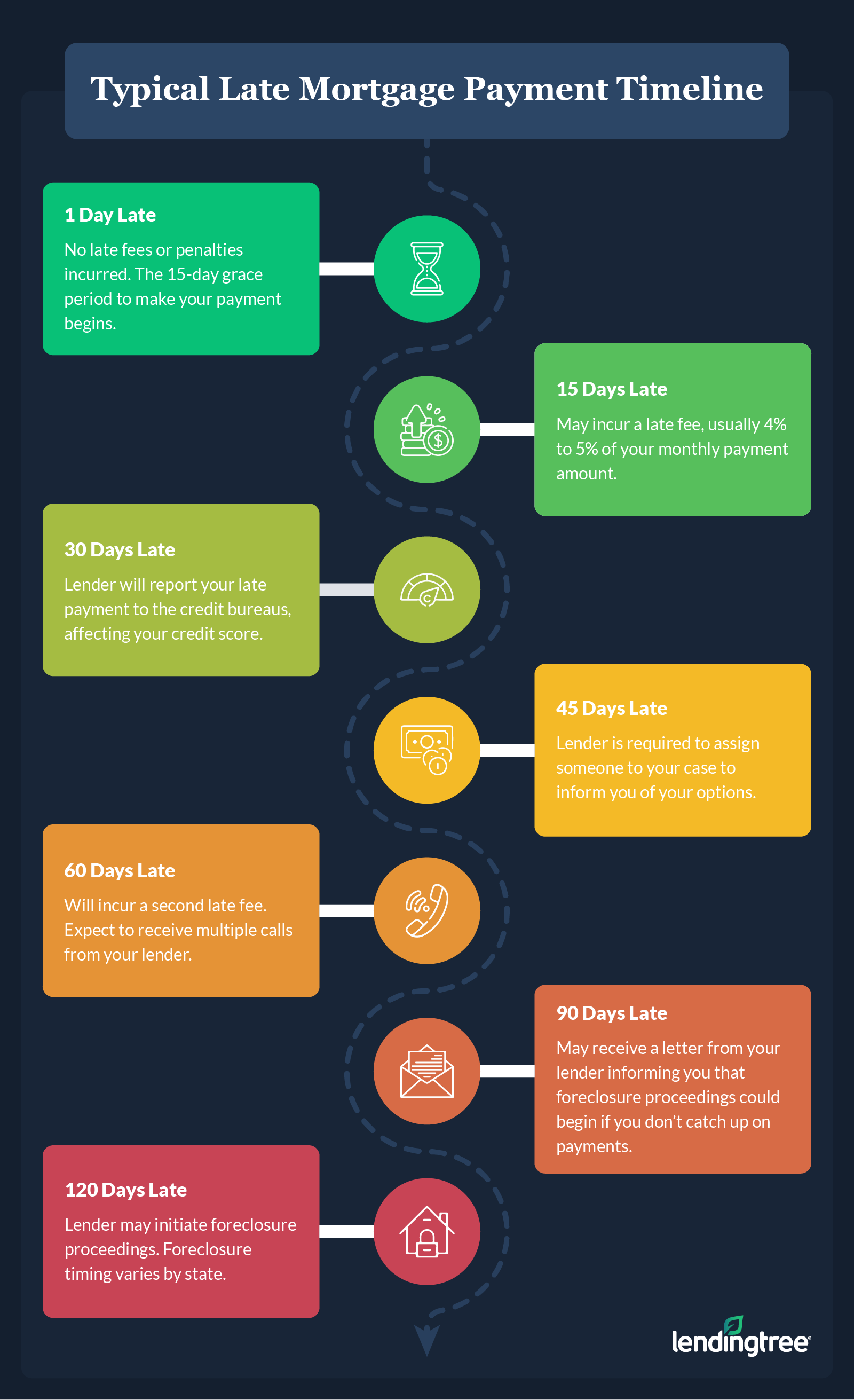What You Need To Know About Late Mortgage Payments
Life happens, and sometimes you may fall behind on bills and make a late mortgage payment, whether by accident or by circumstance. So what actually happens when your mortgage payment is late? The answer can vary from person to person based on your financial history, the rules of your specific mortgage and how late your payment is.
Due dates, grace periods and late mortgage payments
If you’re struggling to pay your mortgage and are wondering what’s considered a late mortgage payment, your first step should be finding your promissory note in your loan paperwork.
It might say something like, “I will make my monthly payment on the 1st day of each month beginning on Aug. 1, 2021,” and show the mailing address for your payments and the principal and interest amount due monthly.
Here’s a breakdown of the late mortgage payment timeline:

1 day late
Most mortgage payments are due on the first of the month. Although your payment is technically late, most mortgage servicers won’t give you a late payment penalty after only a day late because of the mortgage grace period, which is the set time after your due date during which you can still make a payment without incurring a penalty. For most mortgages, the grace period is 15 calendar days. So if your mortgage payment is due on the first of the month, you have until the 16th to make the payment.
15 days late
Your grace period typically ends after 15 days. At this point, your lender may assess a late fee for payment due that can be charged each month you miss a payment. These payments can be significant, generally ranging between 4% and 5% of the total overdue balance. Section 6, Borrower’s Failure to Pay as Required, on Form 3200 includes your lender’s grace period and the late fee that applies if you fail to pay before it ends.
30 days late
Your servicer may report the delinquency to the credit bureaus, which can impact your credit (discussed later) since you’ve officially missed a payment. By 36 days late, federal law requires the servicer to try to make contact with you. If they receive no response, the servicer may send a Notice of Default. Procedures for this Notice of Default are also outlined in Form 3200, Section 6 (C).
The Notice of Default may give 30 days’ notice to pay your mortgage balance, plus any accumulated interest and fees, in full. The laws in most states give more time to work out payment arrangements before foreclosure. Keep in mind most lenders would rather work with you to get your mortgage payments current.
45 days late
Federal law requires the servicer to assign a company staff member to your file. This staffer is tasked with connecting you to available assistance options and answering any questions you may have. You will receive a written notice of this assignment.
60 days late
By now, you’ve missed two monthly payments and you’ve likely been charged a second late fee. Your lender has probably called several times, in attempts to discuss why you haven’t made a payment.
If you’re having financial troubles, it may be difficult or embarrassing to discuss, but don’t ignore your lender’s calls. They may be able to work with you or refer you to resources that can help.
90 days late
Once you’ve missed three payments. Your lender will likely send another, more serious notice, known as a “Demand Letter” or “Notice to Accelerate.” It’s essentially a notice to bring your mortgage current or face foreclosure proceedings.
The process and timeline for foreclosure varies from state to state. You can look up information on your state’s foreclosure laws and procedures online.
120+ days late
If you have not paid in full or made other payment arrangements by the deadline spelled out in the Demand Letter, your lender will refer you to their attorney, who will schedule a foreclosure sale. You’ll receive a notice by mail, have a notice taped to your door and the sale may be advertised in your local paper.
How a late mortgage payment affects your credit
Your mortgage lender will likely report your late payment to the three major credit bureaus after 30 days past due, and your credit score will take a hit. Even one late payment can negatively affect your credit score for up to three years, according to FICO.
The effects of late payments can vary, depending on your overall financial history and each credit bureau’s means of calculating your score. Note though, that a borrower with an excellent credit rating — around 780 — could see a drop of 90 to 110 points after one late mortgage payment, according to FICO.
Additionally, the hits to your credit score will only get worse the more you fall behind. Your credit report will indicate whether the payment is 30 or more days late, as well as what was done to resolve the late payment. If your late payments ultimately result in foreclosure, that will remain and continue to affect your credit score for up to seven years.
 GOOD NEWS FOR THOSE WITH A CREDIT SCORE UNDER 680: CONVENTIONAL RATE CHANGES IN 2023
GOOD NEWS FOR THOSE WITH A CREDIT SCORE UNDER 680: CONVENTIONAL RATE CHANGES IN 2023
A higher credit score generally means a better interest rate and, while this is still true, beginning May 1, 2023 conventional loan borrowers with a credit score between 640 and 680 will face less of a penalty for having imperfect credit than they have in the past. That’s good news for many—such as those with a history of late mortgage payments that have affected their credit—who may have struggled to obtain an affordable mortgage. Interestingly, those at the other end of the credit spectrum will see an opposite adjustment: mortgage rates for borrowers with a credit score above 680 will be getting slightly higher.
What happens if you can’t pay your mortgage?
If you reach a point where you’re unable to pay your mortgage, there are several potential options to consider — before facing foreclosure — that could help lessen penalties or keep you in your home.
Housing counseling
You can reach out to a housing counselor approved by the U.S. Department of Housing and Urban Development (HUD) if you’re struggling to pay your mortgage and are looking for foreclosure prevention options.
Whatever your course of action, the housing counselor will explain which documents you’ll need to provide to your mortgage servicer to start the process, and they may even be able to contact the mortgage company on your behalf to help you understand your options. If you’re facing the threat of foreclosure, housing counseling is a great place to start.
Mortgage forbearance
A mortgage forbearance is an option that allows you to temporarily pause or lower your mortgage payments for a set time period if you’re experiencing financial hardship.
The terms of these agreements vary based on factors including the type of loan you have, your loan servicer and the investor requirements on your loan. The one consistency is that after your forbearance period ends, you must repay all missed payments with interest either in a lump sum or over time as part of your regular mortgage payments.
Mortgage modification
A mortgage modification adjusts the original terms of your loan to help make your mortgage payments more affordable. The adjustments can take several different forms, including:
- Adding your past-due balance to your outstanding loan amount and recalculating your repayment term.
- Extending your repayment term, for example, going from 25 to 30 years.
- Lowering your mortgage interest rate.
- Reducing your outstanding principal balance.
Also note that a mortgage modification is not the same as a mortgage refinance, since you’re keeping your original mortgage, just with new terms. Be sure to research what type of program might be best for you and ensure you are only working with legitimate organizations.
Home sale
The cost of selling your home can be expensive if you are already experiencing financial hardship, but is certainly something to consider if you find you can no longer afford your home.
Expenses can include:
- Closing costs
- Home inspection
- Home staging
- Moving costs
- Real estate agent commissions
- Repairs
- Utilities
- Taxes
Before opting to sell your home, make sure you have the necessary funds and an extra cushion for any surprise expenses that could arise.
Short sale
A short sale allows a homeowner who owes more on their house than it is worth to sell their home for less than they owe. The goal is to pay off as much of the balance as possible to reimburse the mortgage lender. In some instances, the lender may even forgive the leftover balance from a short sale.
If you believe this could be the best option for you given your situation, begin by reaching out to your mortgage lender or servicer to determine your eligibility for a short sale.
Deed-in-lieu of foreclosure
A deed-in-lieu of foreclosure, also called a mortgage release, is where you voluntarily transfer the ownership of your home to your lender, to get rid of your mortgage balance without having to repay.
Once you have decided that this option might be best for you, reach out to your lender to determine your eligibility. If they agree that this may be the best option for you, then the process can be completed in as little as 90 days, according to Fannie Mae.
Foreclosure
A foreclosure is the final measure that can be taken when you can’t pay your mortgage for a prolonged period of time. This process involves your lender taking ownership of your home through repossession.
When you take out a mortgage to buy a home, the home itself is what is used as collateral for the loan. If you fail to make payments, your lender repossesses the home. Your credit score will take a serious hit in the case of a foreclosure — up to a 160-point drop, according to FICO — and sticks with you for up to seven years. The good news is there are other options to consider before reaching this point, as outlined above.
